ベクトルの演算
平面ベクトル(教科書範囲) ★
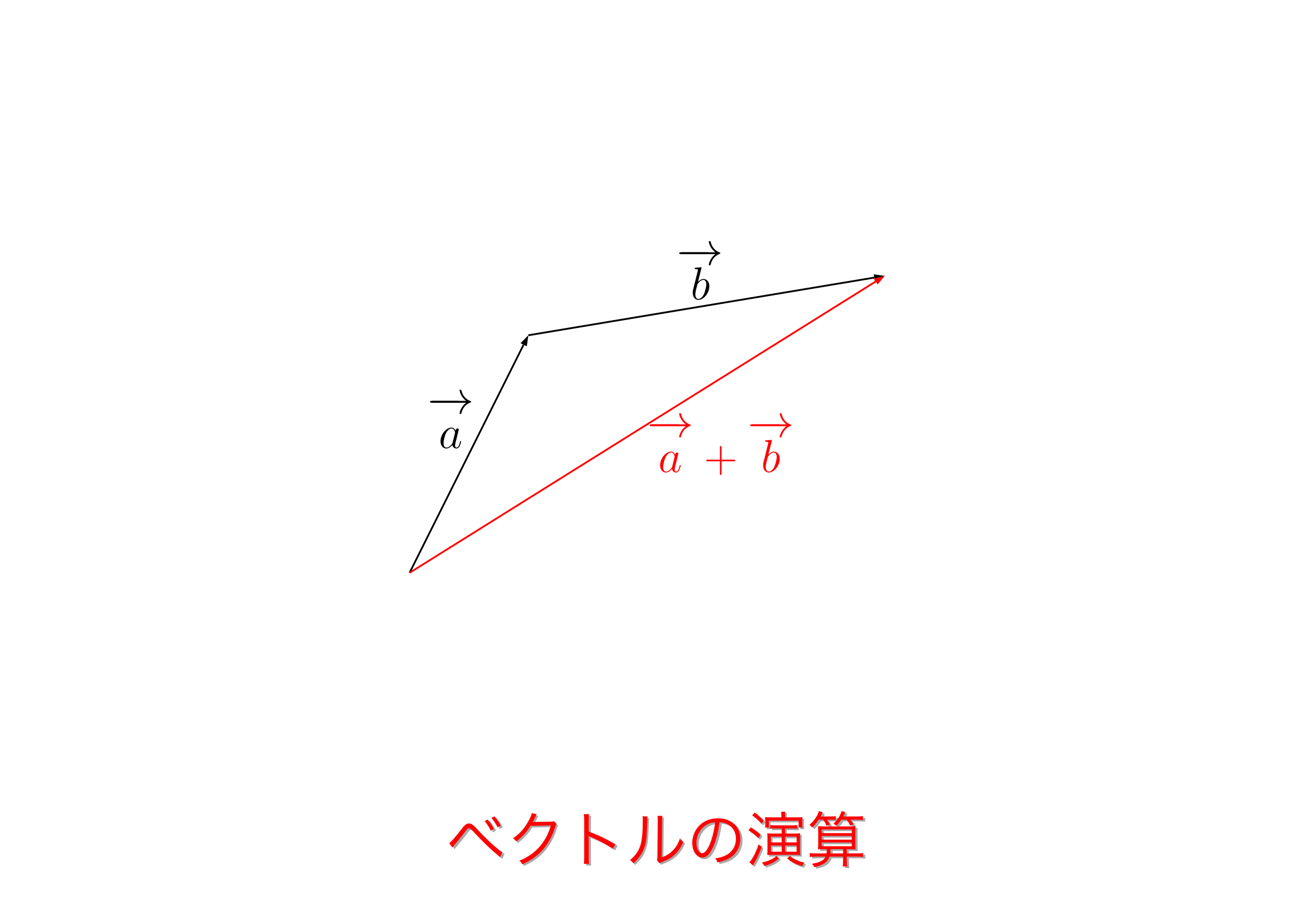
ベクトルの導入をし,基本的な演算をできるようにします.
用語説明が多くなりますが,その後の演習で確認していきましょう.
ベクトルとは
ベクトルとは,向きと大きさをもつ量で矢印で表現します.
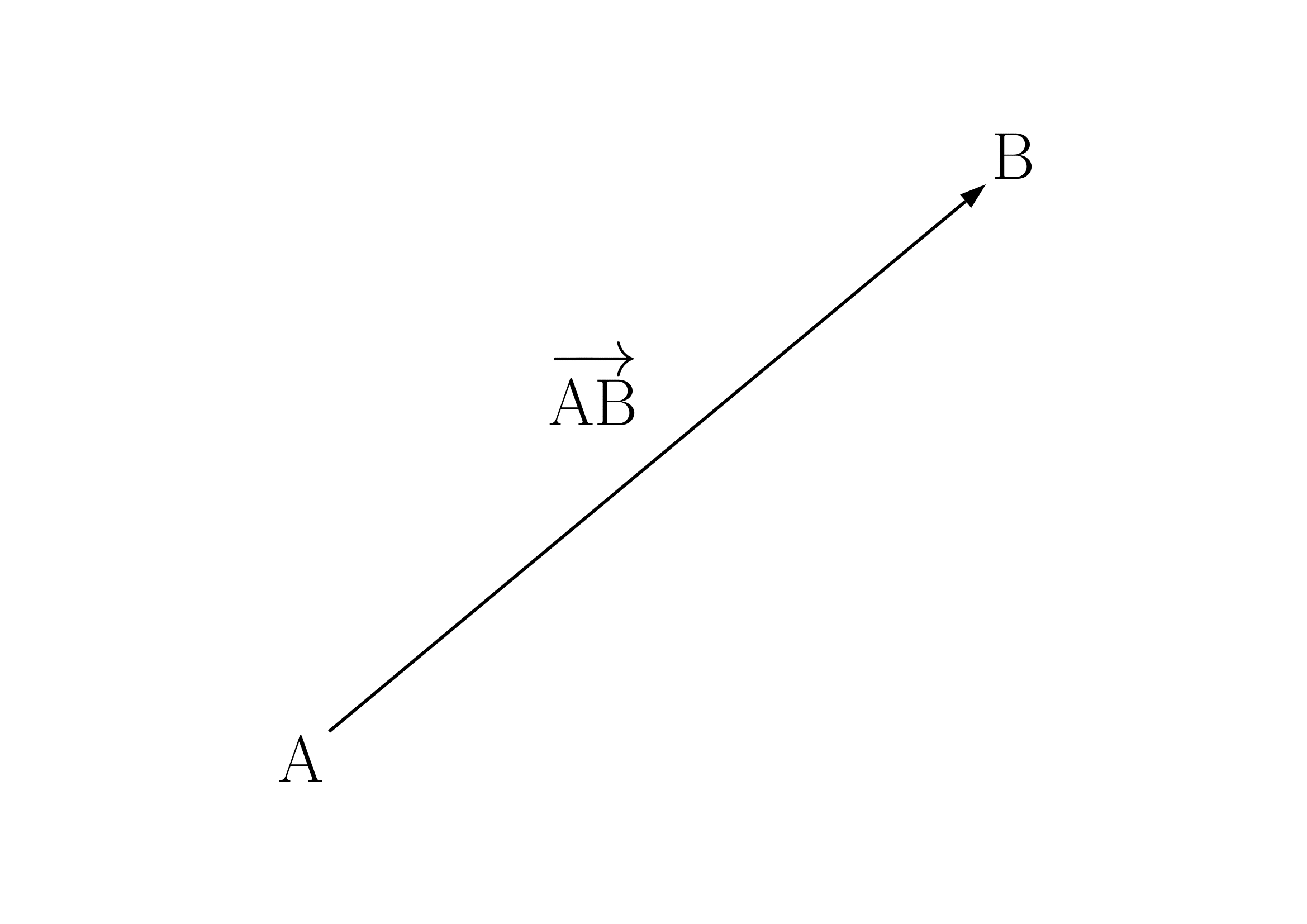
上の図では $\rm A$ が始点,$\rm B$ が終点といい,$\overrightarrow{\mathstrut \rm AB}$ で表します.$\overrightarrow{\mathstrut a}=\overrightarrow{\mathstrut \rm AB}$ などのように1文字でおいて表してもOKです.寧ろ向きと大きさをもつ量を $\overrightarrow{\mathstrut a}$ と簡潔に表現し扱うことに利便性があります.
ベクトルとしては向きと大きさが同じであれば同じベクトルであり,場所が不問であることが特徴です.
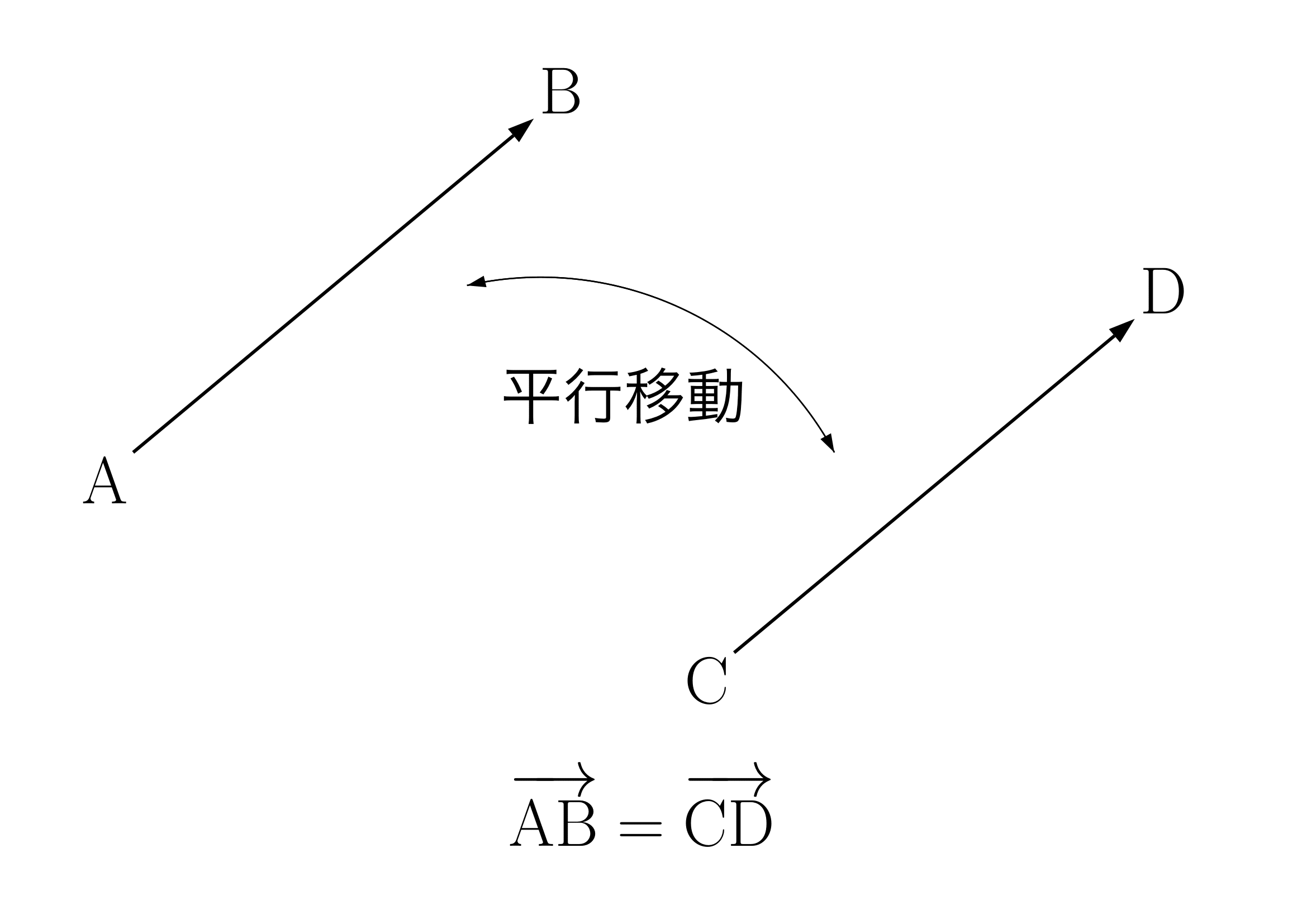
上の図のように,平行移動しただけならベクトルとしては等しいです.
ベクトルの基本
ベクトルは向きと大きさをもつ量.平行移動してもベクトルとしては等しい.
逆ベクトル
$\overrightarrow{\mathstrut a}$ と逆向きのベクトル(逆ベクトル)は $\boldsymbol{-\overrightarrow{\mathstrut a}}$ で表します.
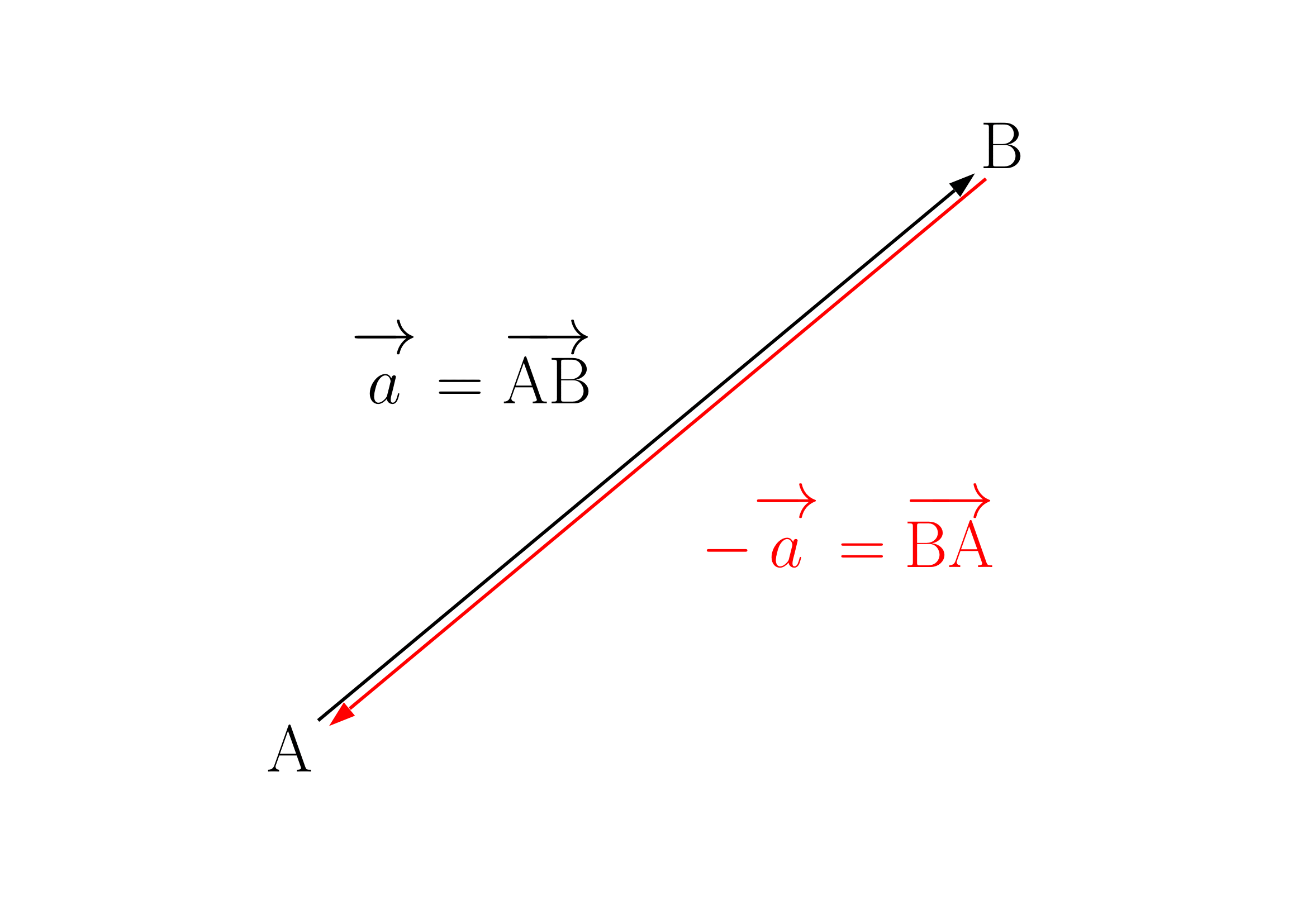
$\overrightarrow{\mathstrut a}=\overrightarrow{\mathstrut \rm AB}$ なら $-\overrightarrow{\mathstrut a}=\overrightarrow{\mathstrut \rm BA}$ となるので一般に
$\overrightarrow{\mathstrut \rm BA}=-\overrightarrow{\mathstrut \rm AB}$
が成り立ちます.
ベクトルの和
ベクトルの和の定義
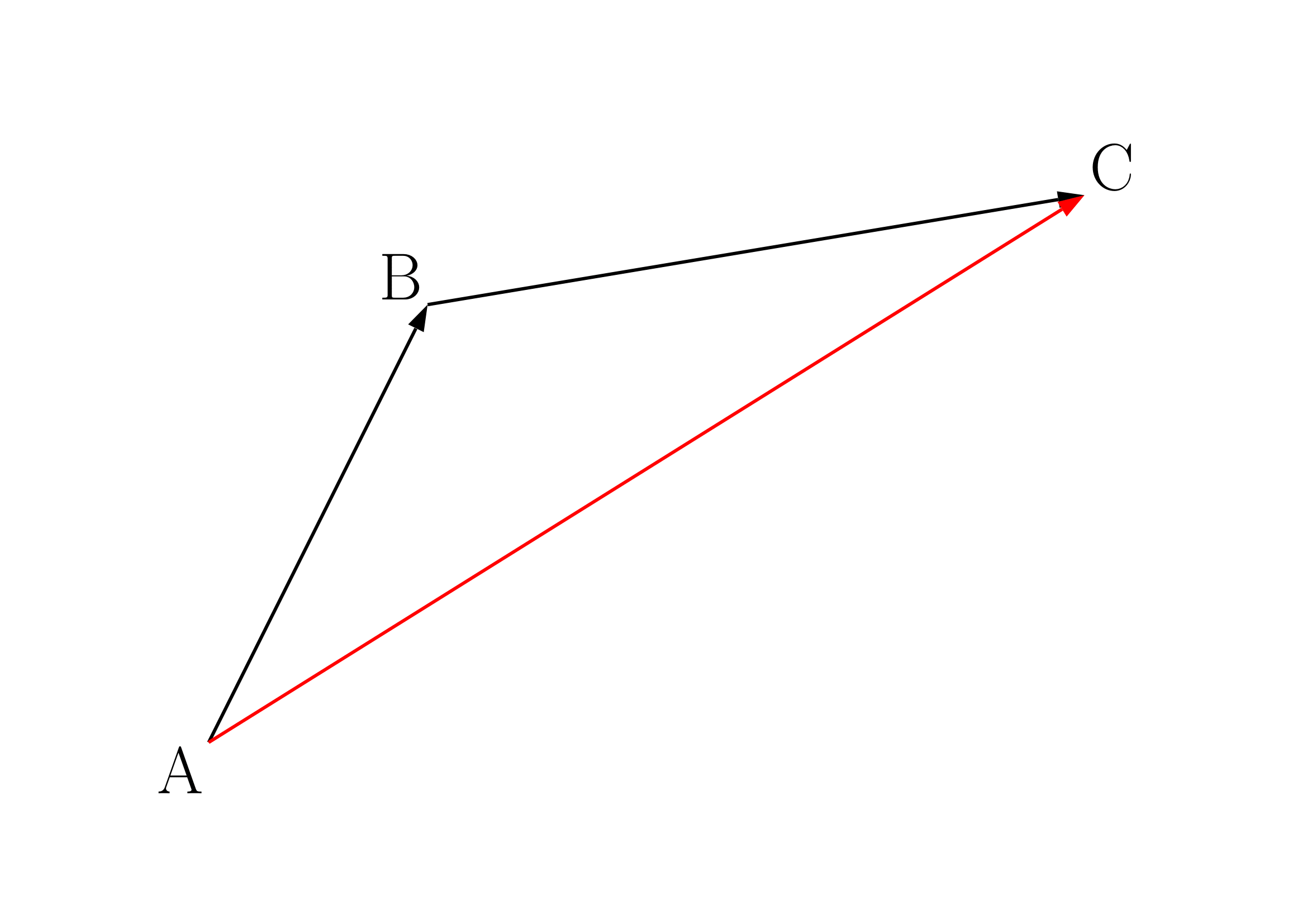
2つのベクトル $\overrightarrow{\mathstrut \rm AB}$,$\overrightarrow{\mathstrut \rm BC}$ に対して,その和を
$\overrightarrow{\mathstrut \rm AB}+\overrightarrow{\mathstrut \rm BC}=\overrightarrow{\mathstrut \rm AC}$
で定める.
※ ベクトルの和にとっては接続した点の $\rm B$ はどこでもいいという意味で,一般に $\overrightarrow{\mathstrut \rm A□}+\overrightarrow{\mathstrut \rm □C}=\overrightarrow{\mathstrut \rm AC}$ が成り立ちます(□は同じ点).
小文字のベクトルで表現した場合以下のようになります.
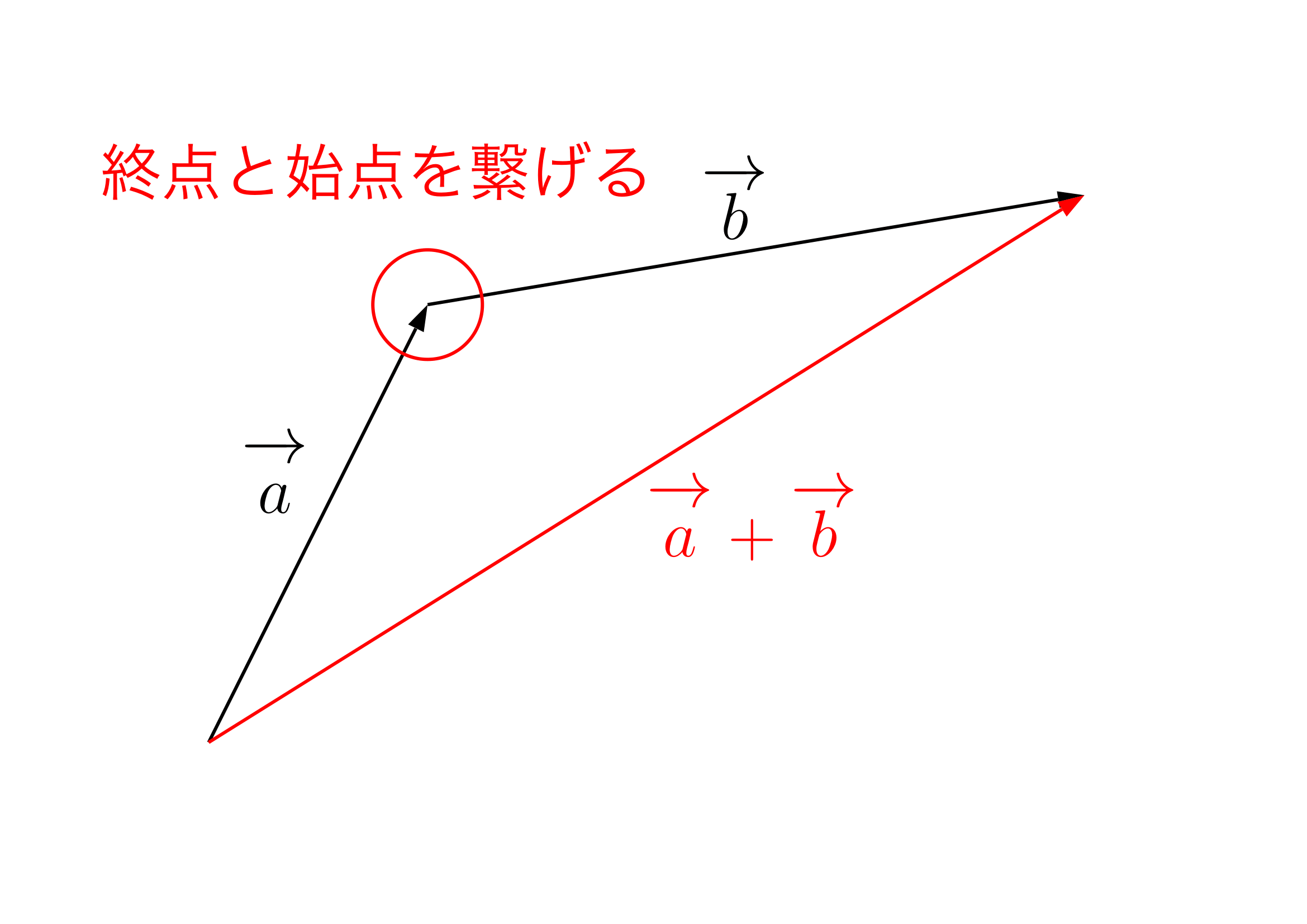
ベクトルの終点と始点を繋げるのがポイントです.最初の始点と最後の終点を結んで和を表現します.
このルールから,以下の性質が容易に確認できます.
ベクトルの加法の性質
$\overrightarrow{\mathstrut a}+\overrightarrow{\mathstrut b}=\overrightarrow{\mathstrut b}+\overrightarrow{\mathstrut a}$ $\cdots$ 交換法則
$(\overrightarrow{\mathstrut a}+\overrightarrow{\mathstrut b})+\overrightarrow{\mathstrut c}=\overrightarrow{\mathstrut a}+(\overrightarrow{\mathstrut b}+\overrightarrow{\mathstrut c})$ $\cdots$ 結合法則
零ベクトル
もし $\overrightarrow{\mathstrut a}=\overrightarrow{\mathstrut \rm AB}$ と $-\overrightarrow{\mathstrut a}=\overrightarrow{\mathstrut \rm BA}$ を足すと
$\overrightarrow{\mathstrut a}+\left(-\overrightarrow{\mathstrut a}\right)$
$=\overrightarrow{\mathstrut \rm AB}+\overrightarrow{\mathstrut \rm BA}$
$=\overrightarrow{\mathstrut \rm AA}$
これは始点と終点が一致しているので向きも大きさも生まれません.これを
零ベクトルの性質
Ⅰ $\overrightarrow{\mathstrut a}+\left(-\overrightarrow{\mathstrut a}\right)=\overrightarrow{\mathstrut 0}$
Ⅱ $\overrightarrow{\mathstrut a}+\overrightarrow{\mathstrut 0}=\overrightarrow{\mathstrut a}$
$\overrightarrow{\mathstrut 0}$ と書くところで $0$ と書かないようにしましょう.しかし計算上はいつもの $0$ と同じです.
ベクトルの差
$\overrightarrow{\mathstrut a}$ と $\overrightarrow{\mathstrut b}$ のベクトルの差は
$\boldsymbol{\overrightarrow{\mathstrut a}-\overrightarrow{\mathstrut b}=\overrightarrow{\mathstrut a}+\left(-\overrightarrow{\mathstrut b}\right)}$
として逆ベクトルの和で処理します.
ベクトルの実数倍,平行条件(一直線上)
$\overrightarrow{\mathstrut a}$ に対して,$k\overrightarrow{\mathstrut a}$ を以下のように定めます.
(ⅰ) $k>0$ のとき,大きさを $k$ 倍
(ⅱ) $k=0$ のとき,零ベクトル.すなわち $0\cdot \overrightarrow{\mathstrut a}=\overrightarrow{\mathstrut 0}$.
(ⅲ) $k<0$ のとき,逆向きで大きさを $|k|$ 倍
例として以下を見てみます.
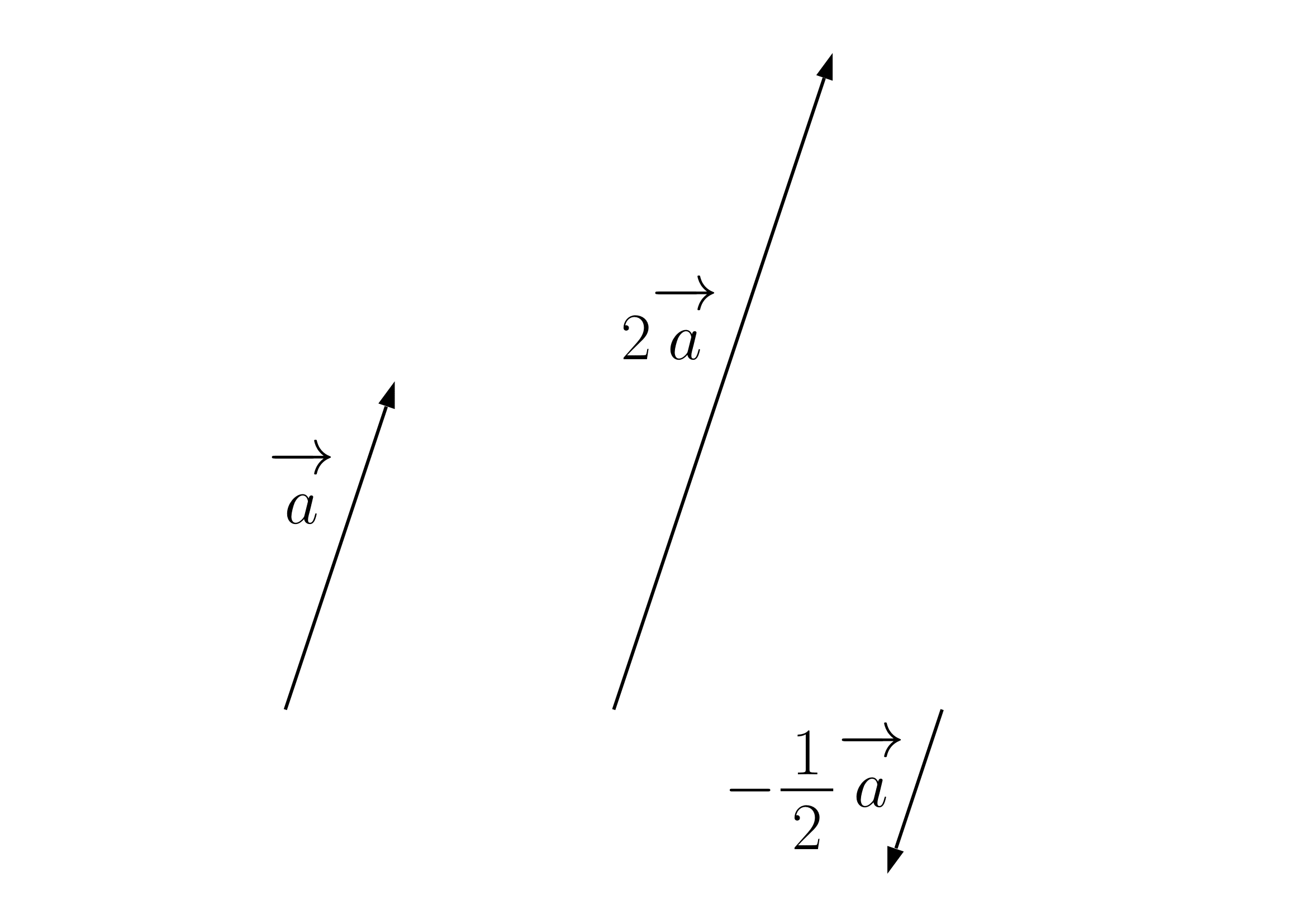
これら実数倍の関係にあるベクトル等は向きは同じなので平行です.
ベクトルの平行条件(一直線上)
$\overrightarrow{\mathstrut a}$ と $\overrightarrow{\mathstrut b}$ が平行(一直線上) $\Longleftrightarrow$ $\overrightarrow{\mathstrut b}=k\overrightarrow{\mathstrut a}$ ( $k$ は実数)
またベクトルの実数倍は以下の性質をもつことが確認できます.
ベクトルの実数倍
Ⅰ $k(l\overrightarrow{\mathstrut a})=kl\overrightarrow{\mathstrut a}$
Ⅱ $(k+l)\overrightarrow{\mathstrut a}=k\overrightarrow{\mathstrut a}+l\overrightarrow{\mathstrut a}$
Ⅲ $k(\overrightarrow{\mathstrut a}+\overrightarrow{\mathstrut b})=k\overrightarrow{\mathstrut a}+l\overrightarrow{\mathstrut b}$
以上で基本的なルールの解説を終えたので,下の演習に取り掛かってみてください.
例題と練習問題
例題
例題
(1)下の図で,等しいベクトルを答えよ.また,互いに逆ベクトルになっているものを答えよ.

(2)下の図で,$\overrightarrow{\mathstrut a}+\overrightarrow{\mathstrut b}$,$\overrightarrow{\mathstrut a}-\overrightarrow{\mathstrut b}$,$-\dfrac{3}{2}\overrightarrow{\mathstrut a}+\dfrac{4}{3}\overrightarrow{\mathstrut b}$ をそれぞれ $\rm O$ を始点とした位置に図示せよ.
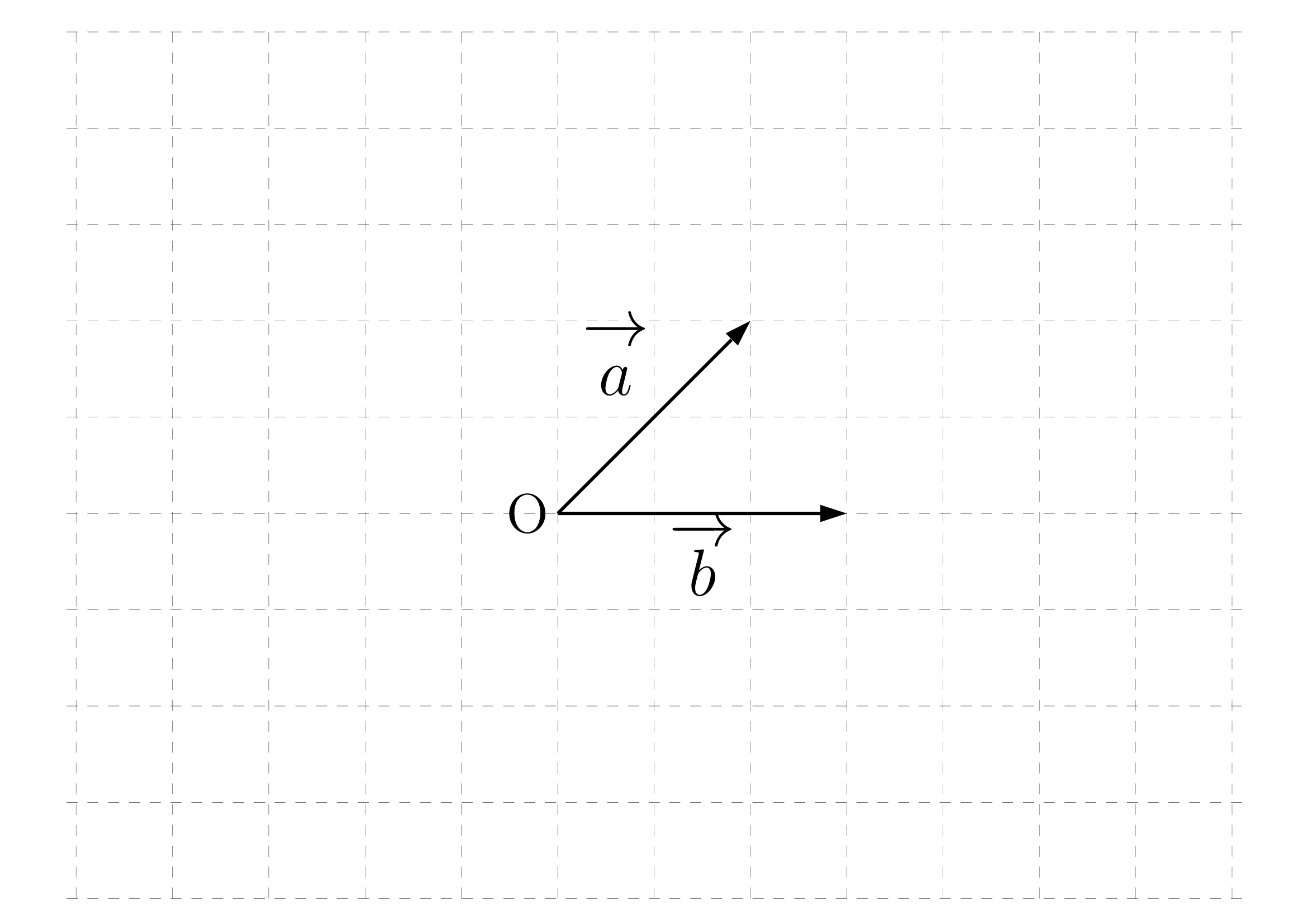
(3) $2(\overrightarrow{\mathstrut a}-2\overrightarrow{\mathstrut b})-4(-\overrightarrow{\mathstrut a}+\overrightarrow{\mathstrut b})$ を簡単にせよ.
講義
(2)では答え合わせの都合で始点を $\rm O$ に指定しました.
(3)ではベクトルを普通の文字の計算と同じように扱います.
解答
(1)
等しいベクトル:$\boldsymbol{\overrightarrow{\mathstrut f} と \overrightarrow{\mathstrut i}}$
互いに逆ベクトル:$\boldsymbol{\overrightarrow{\mathstrut a} と \overrightarrow{\mathstrut k}}$
(2)
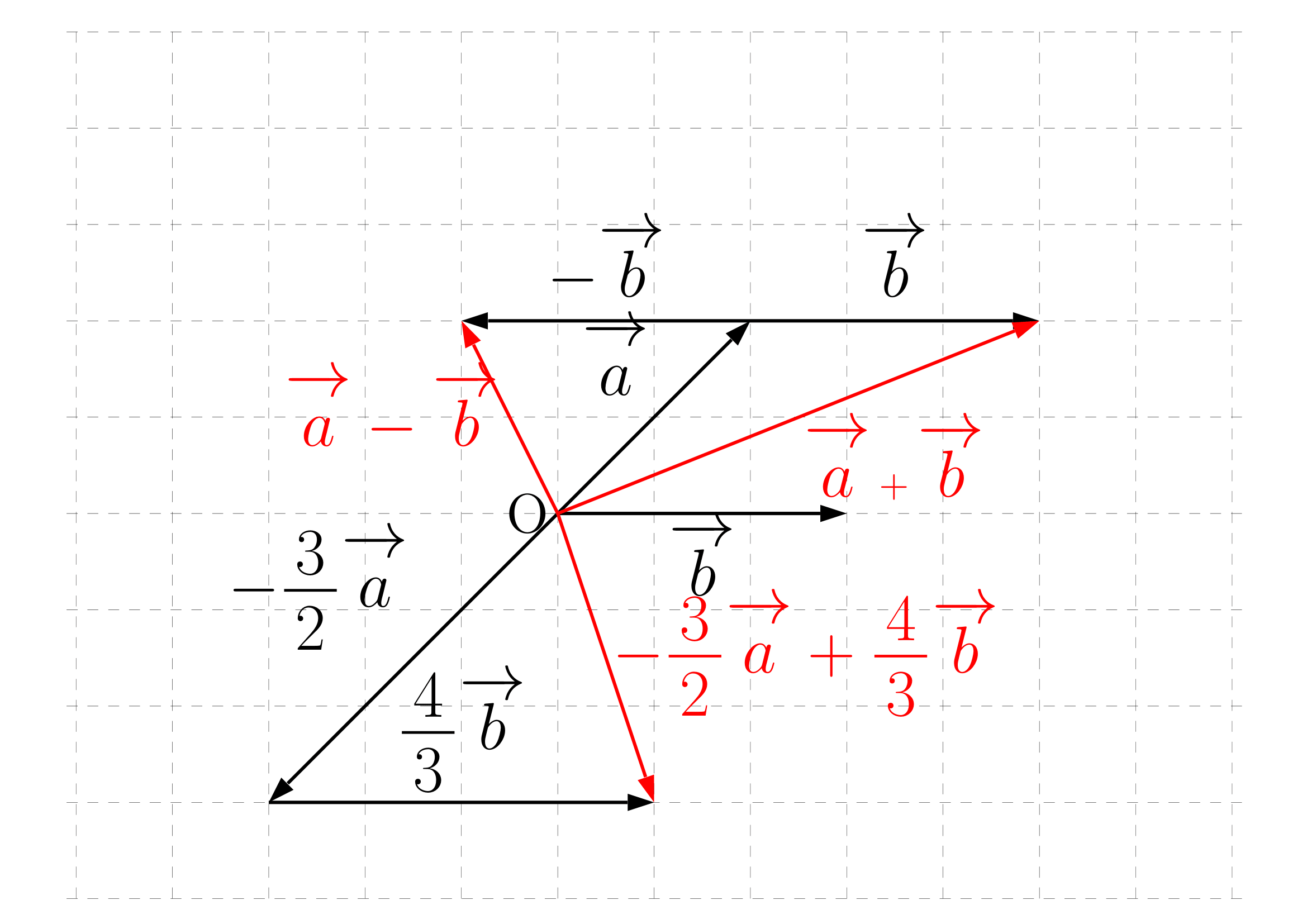
(3)
$2(\overrightarrow{\mathstrut a}-2\overrightarrow{\mathstrut b})-4(-\overrightarrow{\mathstrut a}+\overrightarrow{\mathstrut b})$
$=2\overrightarrow{\mathstrut a}-4\overrightarrow{\mathstrut b}+4\overrightarrow{\mathstrut a}-4\overrightarrow{\mathstrut b}$
$=\boldsymbol{6\overrightarrow{\mathstrut a}-8\overrightarrow{\mathstrut b}}$
練習問題
練習
(1) 下の図で,$\overrightarrow{\mathstrut a}+\overrightarrow{\mathstrut b}$,$-\overrightarrow{\mathstrut a}-\dfrac{5}{3}\overrightarrow{\mathstrut b}$ をそれぞれ $\rm O$ を始点とした位置に図示せよ.

(2) 次の式を満たす $\overrightarrow{\mathstrut x}$ を $\overrightarrow{\mathstrut a}$,$\overrightarrow{\mathstrut b}$ で表せ.
$2(\overrightarrow{\mathstrut x}+\overrightarrow{\mathstrut a})-\overrightarrow{\mathstrut b}=-\overrightarrow{\mathstrut x}+5\overrightarrow{\mathstrut a}$
解答
(1)
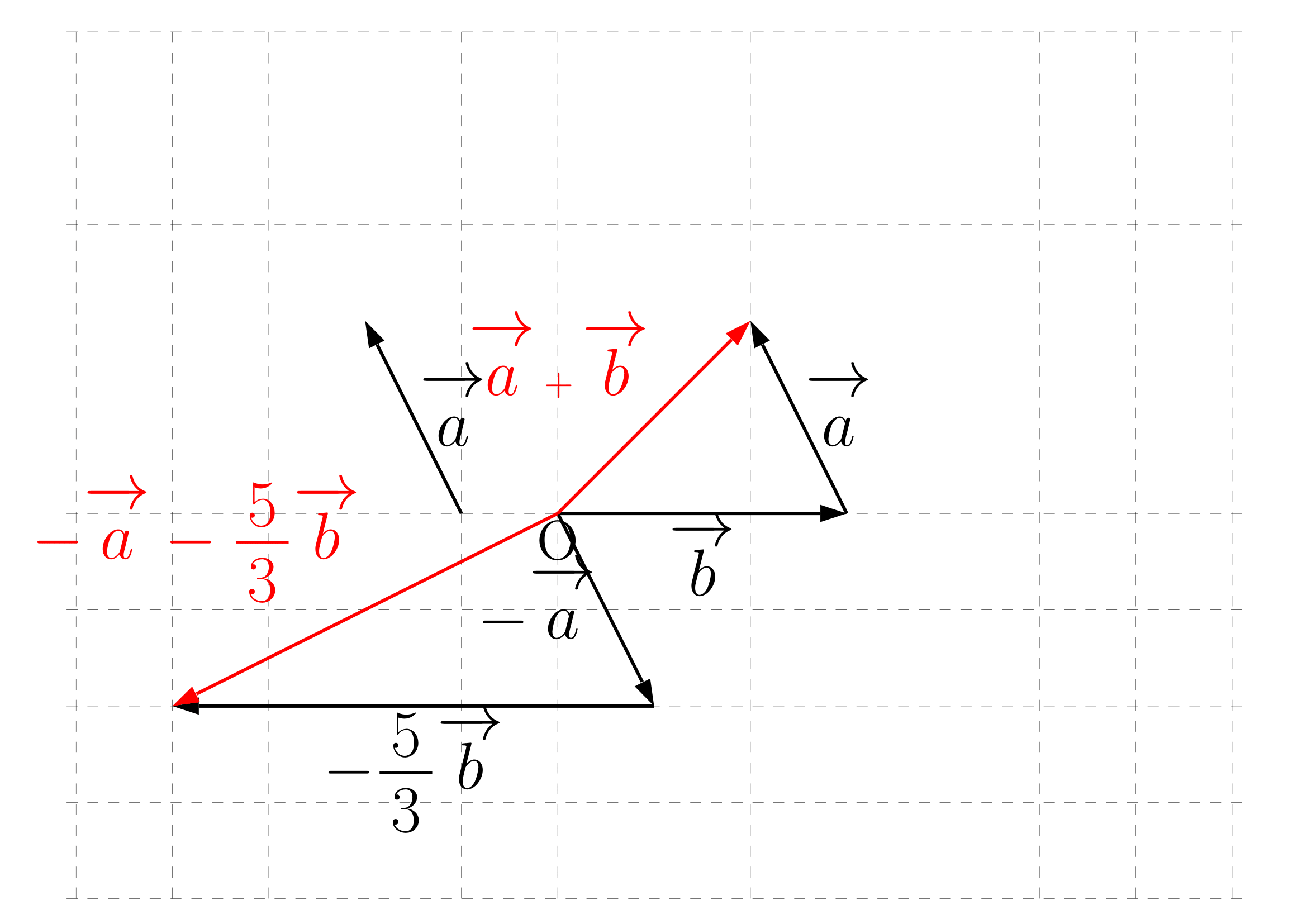
(2)
$2\overrightarrow{\mathstrut x}+2\overrightarrow{\mathstrut a}-\overrightarrow{\mathstrut b}=-\overrightarrow{\mathstrut x}+5\overrightarrow{\mathstrut a}$
$\Longleftrightarrow \ 3\overrightarrow{\mathstrut x}=3\overrightarrow{\mathstrut a}+\overrightarrow{\mathstrut b}$
$\therefore \ \boldsymbol{\overrightarrow{\mathstrut x}=\overrightarrow{\mathstrut a}+\dfrac{1}{3}\overrightarrow{\mathstrut b}}$
